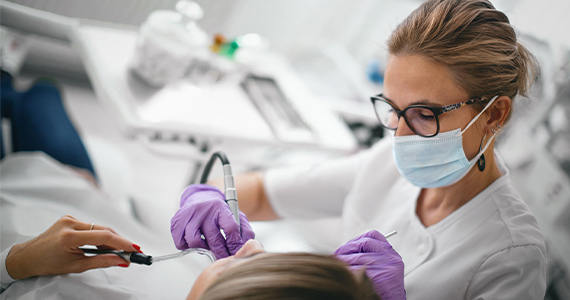Anesthesia for Dental Treatment
Learn more reasons for types, usage and side effects.

Why is Anesthesia Used for Dental Treatment?
Anesthesia is used to help manage pain during surgical procedures and is an integral part of dental care. You are probably familiar with local anesthetics used to numb a treatment area, but did you know there are other reasons a dentist might recommend a different type of anesthesia? This is how dentists decide which type of anesthesia to use:
- Complexity of the procedure (invasiveness or the length of time to complete the procedure).
- Age and level of cooperation (small children, special needs, people who are experiencing dementia or Alzheimer's disease).
- Medical history (allergies, special needs, Parkinson's disease).
- Mental health history (phobias, anxiety).
Types of Anesthesia
Anesthesia options are broken into three general categories:
Local Anesthesia - The most commonly used anesthetic is local anesthesia. It is used to numb a specific area of the mouth and applied topically or by injection. Both the pre-injection numbing gel (topical anesthetic) and the injection itself are different examples of local anesthetics. Local anesthesia is used for minor dental procedures, like fillings, extractions, root canal treatments, crown placement and deep cleanings. The numbing sensation can last for hours.
Sedation - Most often used to help alleviate anxiety or help keep a person from moving during a procedure. It can be administered in mild, moderate or deep strengths, placing the person in different levels of consciousness. Sedation can be given before an appointment via a pill or during the visit via laughing gas or IV. The person is somewhat responsive and can breathe on their own.
General Anesthesia - Most often used for longer dental procedures, general anesthesia results in a complete, but temporary, loss of consciousness. It is most commonly used for invasive dental procedures performed in a hospital or ambulatory surgical center. The care may involve the jaw bones, cancer, cleft lip/palate surgery, complicated extractions or extensive dental services for very young children experiencing the condition known as early childhood caries.
General anesthesia is normally inhaled or administered by IV. Unlike IV sedation, where a person remains semiconscious, a person receiving general anesthesia becomes completely unconscious and requires breathing assistance.
Side Effects of Anesthesia
Dental anesthesia is a commonly used and safe treatment. However, it is very important that the dentist knows your full medical history, allergies and any substance abuse history (including alcohol), so complications can be avoided. Generally, side effects only occur with sedation or general anesthesia; however, some may find they are allergic to a certain local anesthetic. While these allergic reactions are extremely rare, when they do occur, you may experience:
- A rash
- Hives/itchy skin
- Facial swelling
Though side effects of sedation or general anesthesia are also rare when pre-procedure instructions are followed, side effects may include:
- Nausea and/or vomiting
- Dizziness
- Swelling
- Confusion or hallucinations
- Sweating or shivering
- Fatigue
- Lockjaw
Certain groups have a higher risk of side effects, including:
- Pregnant people
- Pediatric patients
- Individuals with special needs
- Older/elderly adults
- Those with liver, lung, heart or kidney problems
- People with neurological conditions
- Individuals taking other sedative medications, like opioids
- Those with a history of allergy to anesthesia medications
The dentist uses many factors to determine the right level of anesthesia you need. Be sure to thoroughly discuss your medical history and individual needs with the dentist. It is important that the advantages, disadvantages, risks and alternatives be weighted and talked about so that you can make an informed decision before treatment is started. These efforts are meant to help keep you as safe as possible during anesthesia procedures.
Risks of Anesthesia
Though complications from dental anesthesia are rare, there are some risks involved, including:
- Allergic reactions
- Low blood pressure
- Heart attack/failure
- Stroke
- Breathing failure
- Death
If you are planning dental treatment using anesthesia, discuss any concerns with your dentist.
Note: The information in this document is not meant to replace the advice of your dentist or another licensed healthcare professional. Talk to your dentist for any specific dental advice.






